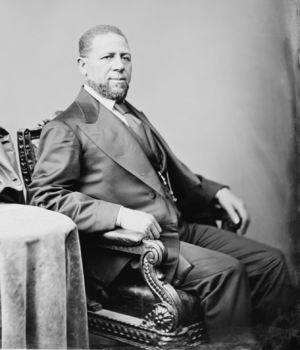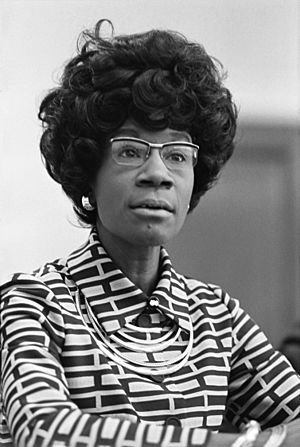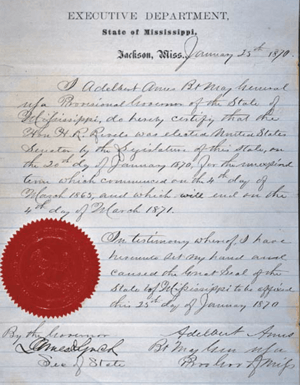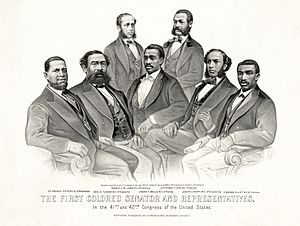African Americans in the United States Congress facts for kids


Since the first United States Congress in 1789, many African Americans have served as lawmakers. By 2020, 162 African Americans had been members of Congress. Most of them (152) served in the House of Representatives, while 9 served in the Senate. One person served in both.
The first African American to serve in Congress was Senator Hiram Rhodes Revels in 1870. Later, in 1949, Representative William L. Dawson became the first to lead a committee in Congress. Shirley Chisholm made history in 1968 as the first African-American woman in Congress. One famous member, Barack Obama, went from being a Senator to becoming President of the United States in 2009.
In 1971, 13 members started the Congressional Black Caucus. This group works to support African-American lawmakers and their communities. By 2019-2020, the group had grown to 56 members.
The first African Americans in Congress were Republicans elected right after the Civil War, during a time called the Reconstruction Era. After slavery ended and Black people gained citizenship, they started to have a voice in politics, especially in the Southern states. However, some white politicians used unfair methods to stop Black people from voting and holding office.
After 1876, laws were passed in the South called Jim Crow laws. These laws created separation and made it very hard for Black people to vote. This meant that for many years, very few African Americans served in Congress.
Later, millions of African Americans moved from the South to cities in the North and West. This was called the Great Migration. In these new places, they could vote more easily. Many of them became Democrats, especially after President Franklin D. Roosevelt's New Deal programs helped people during the Great Depression. The Civil Rights Movement in the 1960s finally led to new laws that protected voting rights for all, allowing more African Americans to be elected to Congress.
Contents
African Americans in Congress: A Look Back
Reconstruction and Early Representation


After the American Civil War, important changes were made to the U.S. Constitution. These changes gave Black people the right to vote and serve in Congress.
- The 13th Amendment (1865) ended slavery.
- The 14th Amendment (1868) made all people born in the U.S. citizens.
- The 15th Amendment (1870) said that no one could be stopped from voting because of their race.
These changes helped Black people gain political power, especially in the Southern states. In some states, like Mississippi and South Carolina, Black people made up most of the population. They worked with white people who supported the Union to gain control of state governments.
On February 25, 1870, Hiram Rhodes Revels became the first African American to serve in the Senate. He was from Mississippi. Later, Blanche Bruce, also from Mississippi, became the second Black Senator in 1875.
In the House of Representatives, Joseph Rainey of South Carolina was elected in 1870. He was the first directly elected Black member of Congress. Other Black representatives were elected from states like Alabama, Florida, Georgia, Louisiana, and Virginia. All of these early Black lawmakers were members of the Republican Party. This was the party of Abraham Lincoln, who ended slavery.
However, after 1868, elections in the South became very unfair. Groups used threats and violence to stop Black people from voting. This was an effort to regain power for the Democratic Party.
In 1877, a deal called the Compromise of 1877 led to federal troops leaving the South. This allowed Southern Democrats to take back control.
Disenfranchisement and Lost Rights
Once Southern Democrats regained power, they passed laws to make it harder for Black people to vote. These laws included:
- Poll taxes: People had to pay a fee to vote. Many poor Black people could not afford this.
- Literacy tests: Voters had to pass difficult reading and writing tests. These tests were often unfair and designed to fail Black voters.
- Residency requirements: Strict rules about how long someone had to live in a place before voting.
These laws, along with Jim Crow laws that created segregation, stopped most Black people from voting. They also faced increased violence and threats.
The last Black congressman elected from the South in the 19th century was George Henry White of North Carolina. His term ended in 1901. After that, no Black person served in Congress for 28 years. It would be 72 years before another Black person represented a Southern state.
The Modern Era of Representation
From 1910 to 1970, millions of Black people moved from the rural South to Northern and Western cities. This was the Great Migration. In these new cities, like New York, Chicago, and Los Angeles, Black people could vote more freely. This led to the creation of congressional districts where Black people were the majority.
In 1928, Oscar Stanton De Priest became the first Black congressman of the modern era, representing Chicago. He was a Republican. Later, Arthur Wergs Mitchell became the first African-American Democrat elected to Congress in 1935.
During the Great Depression, many Black voters switched from the Republican Party to the Democratic Party. This was because President Franklin D. Roosevelt's New Deal programs offered help and jobs. This shift continued, and by the 1960s, most Black voters were Democrats.
A major turning point was the Voting Rights Act of 1965. This law, passed after years of effort by the Civil Rights Movement, finally protected the voting rights of Black people in the South. It also helped end legal segregation.
On January 3, 1969, Shirley Chisholm became the first African-American congresswoman. Two years later, she helped start the Congressional Black Caucus.
For a long time, most Black members of the House were elected from big cities in the North and West. But after the 1990 census, new congressional districts were drawn. These new districts were sometimes created to have a majority of African-American residents. This helped more Black Democrats get elected from Southern states for the first time since Reconstruction. It also increased the number of Black-majority districts in other states like California and Maryland.
Both major political parties supported creating these districts for different reasons. Democrats saw it as a way to achieve fairness and connect with Black voters. Republicans believed it could help them win in other districts by moving Democratic voters into these new areas.
Since the 1940s, nine African Americans have served in the Senate:
- Edward Brooke, a Republican from Massachusetts.
- Carol Moseley Braun, Barack Obama, and Roland Burris, all Democrats from Illinois.
- Tim Scott, a Republican from South Carolina.
- Mo Cowan, a Democrat from Massachusetts.
- Cory Booker, a Democrat from New Jersey.
- Kamala Harris, a Democrat from California.
- Raphael Warnock, a Democrat from Georgia.
List of African Americans in the United States Congress

United States Senate
United States House of Representatives
See Also
- Congressional Black Caucus
- History of African Americans in the United States House of Representatives
- List of African-American United States representatives
- List of African-American United States senators


